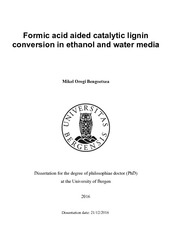| dc.contributor.author | Oregui Bengoetxea, Mikel | |
| dc.date.accessioned | 2017-04-04T07:53:53Z | |
| dc.date.available | 2017-04-04T07:53:53Z | |
| dc.date.issued | 2016-12-21 | |
| dc.identifier.uri | https://hdl.handle.net/1956/15655 | |
| dc.description.abstract | The viability of future lignocellulosic bio-refineries is highly dependent on the efficient conversion of the lignin component. A promising and relatively new lignin conversion methodology is the Lignin-to-Liquid (LtL) process, which involves the conversion of the lignin biopolymer in a reducing formic acid/solvent media. However, in order to make this process economically competitive, some important process parameters need to be improved: (i) shorter reaction times, (ii) lower reaction temperatures and (iii) the reduction of low-value side streams i.e., gas and solid phases. One possibility to address these challenges is the use of heterogeneous catalysts in the process. The main focus of this work was therefore the systematical evaluation of different catalysts for the LtL process. Additionally, the valorization of the lowvalue solid phase into magnetic activated carbons (MACs) was investigated. MACs were produced by KOH chemical activation of the LtL solids (hydrochars) and were further evaluated as CO2 sorbents and catalytic supports. The activity of different noble metal catalysts such as Rh/Al2O3, Pd/Al2O3, Ru/Al2O3 and Ru/C was studied using both ethanol and water as solvents. Traditional NiMo catalysts supported on Al2O3, ZrO2 and MACs, on the other hand, were analyzed only in ethanol media. The results suggest that the activity of the catalyst is highly dependent on the type of metallic system; the effect of the support in the activity of the catalyst is limited, although it is a key factor when evaluating its stability upon recycling. Noble metal based catalysts increased the oil yield and reduced the solid yield for all the reaction conditions and solvent systems studied. NiMo, catalysts, on the other hand, were only active in ethanol media and at high temperatures (i.e. 320 °C or above). The oil yield at low temperatures (i.e. 300 °C) could be, however, increased by supporting the NiMo species over renewable MACs. The catalyst screening approach carried out in this work revealed the complexity of the LtL system: several chemical reactions such as aliphatic ether bond cleavage, HDO and alkylation reactions involving the depolymerized lignin monomers and formic acid decomposition occur simultaneously. The formic acid aided aliphatic ether bond cleavage was the most relevant reaction for the production of bio-oil. It was found that formic acid induces a lignin degradation mechanism different from the one induced by other hydrogen sources such as H2 or isopropanol. The exact reaction mechanism is not fully understood but is believe to happen through a formylationelimination- hydrogenolysis/hydrolysis mechanism. HDO and alkylation reactions contribute to a lesser extent to the production of bio-oil by stabilizing the lignin monomers and hindering their re-polymerization. Furthermore, alkylation reactions could also be favored by selecting a suitable solvent. | en_US |
| dc.language.iso | eng | eng |
| dc.publisher | The University of Bergen | en_US |
| dc.relation.haspart | Paper I: Bengoechea, M.O., Hertzberg, A., Miletić, N., Arias, P.L. and Barth, T., 2015. Simultaneous catalytic de-polymerization and hydrodeoxygenation of lignin in water/formic acid media with Rh/Al 2 O 3, Ru/Al 2 O 3 and Pd/Al 2 O 3 as bifunctional catalysts. Journal of Analytical and Applied Pyrolysis, 113, pp.713-722. The article is available in the main thesis. The article is also available at: <a href="http://dx.doi.org/10.1016/j.jaap.2015.04.020" target="blank">http://dx.doi.org/10.1016/j.jaap.2015.04.020</a> | en_US |
| dc.relation.haspart | Paper II: Oregui Bengoechea, M., Miletíc, N., Vogt, M.H., Arias, P.L. and Barth, T., 2017. Analysis of the effect of temperature and reaction time on yields, compositions and oil quality in catalytic and non-catalytic lignin solvolysis in a formic acid/water media using experimental design. Bioresource Technology. The article is available in the main thesis. The article is also available at: <a href="http://dx.doi.org/10.1016/j.biortech.2017.02.129" target="blank">http://dx.doi.org/10.1016/j.biortech.2017.02.129</a> | en_US |
| dc.relation.haspart | Paper III: Hao, W.; Björnerbäck, F.; Trushkina, Y.; Oregui Bengoechea, M.; Salazar- Alvarez, G.; Barth, T.; Hedin, N. High-performance magnetic activated carbon from renewable resources. Part I: using solid waste from lignin conversion processes. Full text not available in BORA. | en_US |
| dc.relation.haspart | Paper IV: Oregui Bengoechea, M.; Miletíc, N.; Hao, W.; Björnerbäck, F.; Rosnes M. H.; Hedin, N.; Arias, P.L.; Barth, T. High-performance magnetic activated carbon from renewable resources. Part II: Evaluation as NiMo catalyst supports. Full text not available in BORA. | en_US |
| dc.relation.haspart | Paper V: Oregui Bengoechea, M.; Miletíc, N.; Simonsen, S.F.; Kronstad A.; Gandarias, I.; Arias, P.L.; Barth, T. Thermocatalytic conversion of lignin in ethanol/formic acid media with NiMo/Al2O3 and NiMo/ZrO2 catalysts. Full text not available in BORA. | en_US |
| dc.relation.haspart | Paper VI: Oregui Bengoechea, M., Gandarias, I., Arias, P.L. and Barth, T., 2017. Unraveling the role of formic acid and the type of solvent in the catalytic conversion of lignin: A holistic approach. ChemSusChem, 10(4), pp.754-766. The article is available in the main thesis. The article is also available at: <a href="http://dx.doi.org/10.1002/cssc.201601410" target="blank">http://dx.doi.org/10.1002/cssc.201601410</a> | en_US |
| dc.title | Formic acid aided catalytic lignin conversion in ethanol and water media | en_US |
| dc.type | Doctoral thesis | |
| dc.rights.holder | Copyright the Author. All rights reserved | en_US |
| dc.identifier.cristin | 1419256 | |
